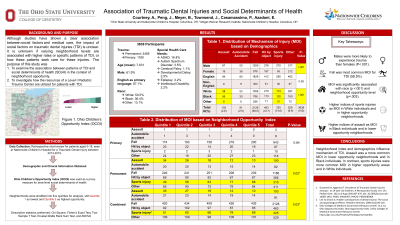Trauma
19 - Traumatic Dental Injuries and Social Determinants of Health


Amber Y. Courtney, DMD, MS (she/her/hers)
Pediatric Dental Resident
The Ohio State University and Nationwide Children's Hospital
The Ohio State University and Nationwide Children's Hospital
Columbus, Ohio, United States
Ehsan N. Azadani, DDS, MS
Assistant Professor and Attending
The Ohio State University and Nationwide Children's Hospital
The Ohio State University and Nationwide Children's Hospital
Columbus, Ohio, United States
Kim Hammersmith, DDS, MPH, MS
Program Director
The Ohio State University and Nationwide Children's Hospital
The Ohio State University and Nationwide Children's Hospital
Columbus, Ohio, United States
Presenting Author(s)
Research Mentor(s)
Program Director(s)
Introduction: The primary aim of this study was to examine the association between patterns of traumatic dental injuries (TDI) and social determinants of health in the context of neighborhood opportunity.
Methods: A retrospective chart review was completed for patients aged 0-18, treated at Nationwide Children’s Hospital for a TDI between 2013-2019. Primary outcomes of interest were the correlation between mechanism of dental injuries (MOIs), hospital utilization, and follow-up visits, with demographics and neighborhood index using Ohio Children’s Opportunity Index.
Results: A total of 3,639 children, mean age 7.6 years, were included in this study. Males (61.9%) were more likely to experience TDI (p < .001). There was a significant association between race and MOI (p < .001). Blacks had a higher incidence of assault contrasting with Whites who had a higher incidence of sports injuries. There was a significant association between the patterns of MOI and neighborhood opportunity index (p= .015). Lower opportunity neighborhoods had higher incidence of assault whereas in higher opportunity neighborhoods there was a higher incidence of sports injuries. No statistical differences were noted in the utilization of hospital resources, frequency of follow-up appointments, and severity of TDI between neighborhoods with different opportunity indices.
Conclusions: This study identified associations between patterns of TDI and social determinants of health. Race and neighborhood opportunity were related to mechanisms of injury. This information can be useful in developing targeted interventions and policies addressing health disparities due to social factors.
Identify Supporting Agency and Grant Number: This study was supported by internal departmental funds at Nationwide Children's Hospital.

.jpg)